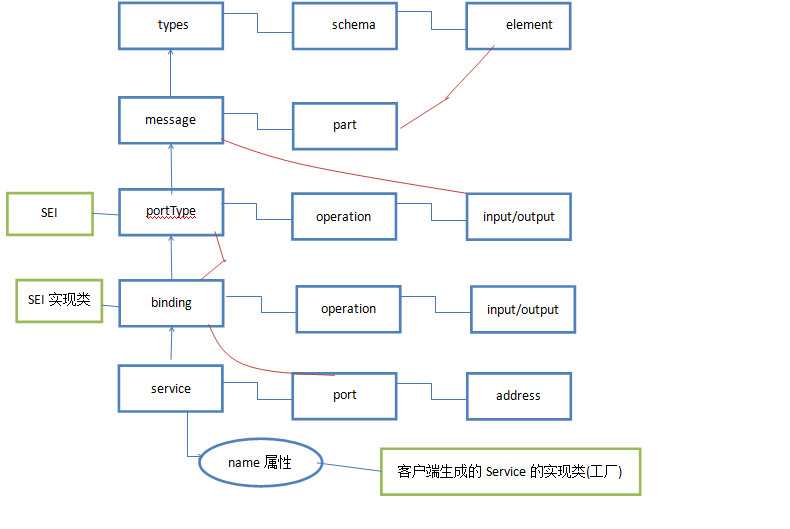标签:
借助jdk的wsimort.exe工具生成客户端代码 格式:wsimport -keep url //url为wsdl文件的路径

直接生成客户端代码会抛异常, 无法生成客户端代码, 解决办法:
将 <s:element ref="s:schema" /><s:any /> 替换成 <s:any minOccurs="2" maxOccurs="2"/>
备注: 这个是Java调用net的webservice都有的问题
<?xml version=‘1.0‘ encoding=‘UTF-8‘?> <wsdl:definitions xmlns:xsd="http://www.w3.org/2001/XMLSchema" xmlns:wsdl="http://schemas.xmlsoap.org/wsdl/" xmlns:tns="http://ws.day01_ws.atguigu.com/" xmlns:soap="http://schemas.xmlsoap.org/wsdl/soap/" xmlns:ns1="http://schemas.xmlsoap.org/soap/http" name="HelloWSImplService" targetNamespace="http://ws.day01_ws.atguigu.com/"> <!-- types schema : 定义了一些标签结构 --> <wsdl:types> <xs:schema xmlns:xs="http://www.w3.org/2001/XMLSchema" xmlns:tns="http://ws.day01_ws.atguigu.com/" elementFormDefault="unqualified" targetNamespace="http://ws.day01_ws.atguigu.com/" version="1.0"> <!-- //用于请求 <sayHello> <arg0>string</arg0> </sayHello> <q0:sayHello> <arg0>BB</arg0> </q0:sayHello> //用于响应 <sayHelloResponse> <return>string</return> </sayHelloResponse> <ns2:sayHelloResponse"> <return>Hello BB</return> </ns2:sayHelloResponse> --> <xs:element name="sayHello" type="tns:sayHello" /> <xs:element name="sayHelloResponse" type="tns:sayHelloResponse" /> <xs:complexType name="sayHello"> <xs:sequence> <xs:element minOccurs="0" name="arg0" type="xs:string" /> </xs:sequence> </xs:complexType> <xs:complexType name="sayHelloResponse"> <xs:sequence> <xs:element minOccurs="0" name="return" type="xs:string" /> </xs:sequence> </xs:complexType> </xs:schema> </wsdl:types> <!-- message: 用来定义消息的结构 soap消息 part : 指定引用types中定义的标签片断 --> <wsdl:message name="sayHelloResponse"> <wsdl:part element="tns:sayHelloResponse" name="parameters"> </wsdl:part> </wsdl:message> <wsdl:message name="sayHello"> <wsdl:part element="tns:sayHello" name="parameters"> </wsdl:part> </wsdl:message> <!-- portType: 用来定义服务器端的SEI operation : 用来指定SEI中的处理请求的方法 input : 指定客户端应用传过来的数据, 会引用上面的定义的<message> output : 指定服务器端返回给客户端的数据, 会引用上面的定义的<message> --> <wsdl:portType name="HelloWS"> <wsdl:operation name="sayHello"> <wsdl:input message="tns:sayHello" name="sayHello"> </wsdl:input> <wsdl:output message="tns:sayHelloResponse" name="sayHelloResponse"> </wsdl:output> </wsdl:operation> </wsdl:portType> <!-- binding : 用于定义SEI的实现类 type属性: 引用上面的<portType> <soap:binding style="document"> : 绑定的数据是一个document(xml) operation : 用来定义实现的方法 <soap:operation style="document" /> 传输的是document(xml) input: 指定客户端应用传过来的数据 <soap:body use="literal" /> : 文本数据 output : 指定服务器端返回给客户端的数据 <soap:body use="literal" /> : 文本数据 --> <wsdl:binding name="HelloWSImplServiceSoapBinding" type="tns:HelloWS"> <soap:binding style="document" transport="http://schemas.xmlsoap.org/soap/http" /> <wsdl:operation name="sayHello"> <soap:operation soapAction="" style="document" /> <wsdl:input name="sayHello"> <soap:body use="literal" /> </wsdl:input> <wsdl:output name="sayHelloResponse"> <soap:body use="literal" /> </wsdl:output> </wsdl:operation> </wsdl:binding> <!-- service : 一个webservice的容器 name属性: 它用一指定客户端容器类 port : 用来指定一个服务器端处理请求的入口(就SEI的实现) binding属性: 引用上面定义的<binding> address : 当前webservice的请求地址 --> <wsdl:service name="HelloWSImplService"> <wsdl:port binding="tns:HelloWSImplServiceSoapBinding" name="HelloWSImplPort"> <soap:address location="http://192.168.10.165:8888/day01_ws/hellows" /> </wsdl:port> </wsdl:service> </wsdl:definitions>
总体就是下面这个结构:
|
<definitions> <types> <schema> <element> </types> <message> <part> </message> <portType> <operation> <input> <output> </portType> <binding> <operation> <input> <output> </binding> <service> <port> <address> </service> </definitions> |
文档结构图:

标签:
原文地址:http://www.cnblogs.com/yangh965/p/5046841.html